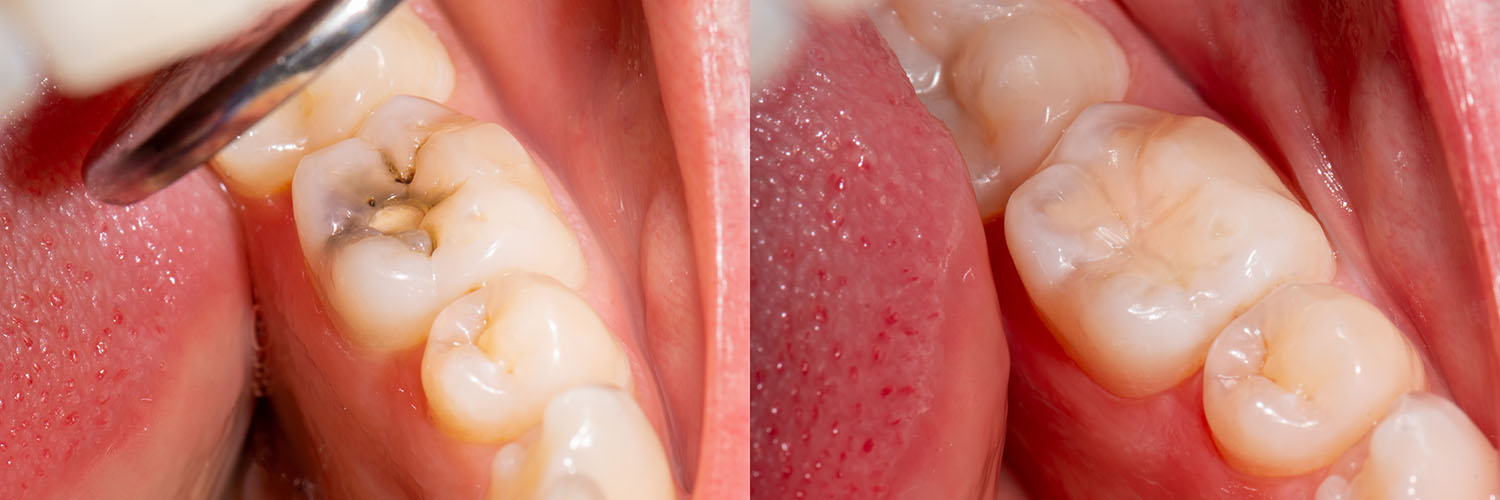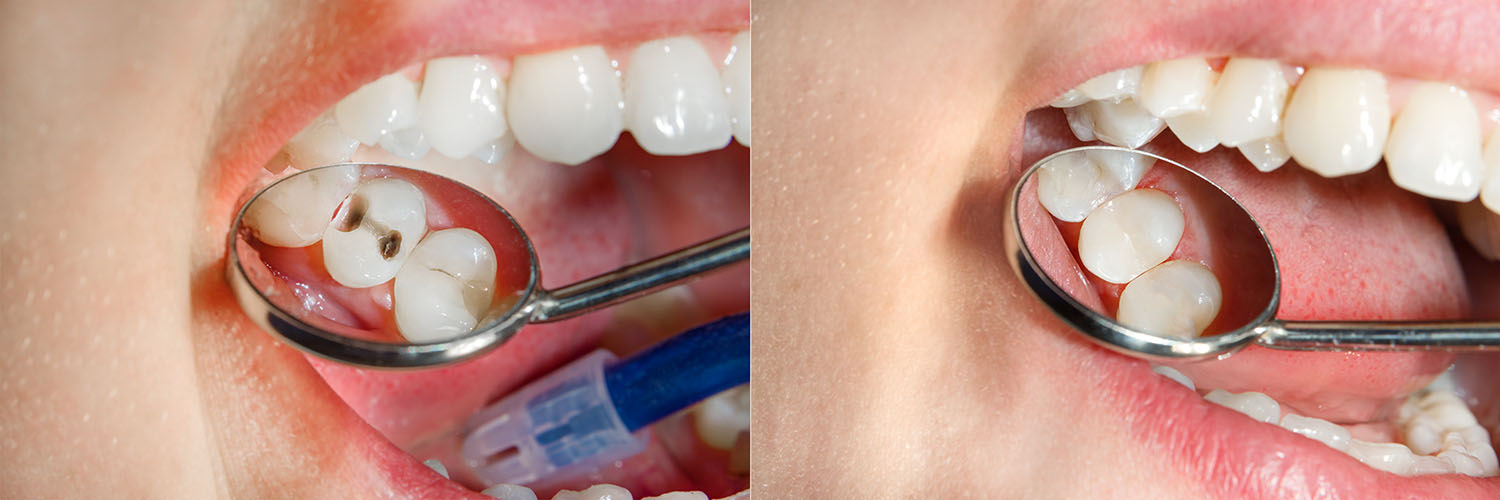
Our Office
2615 West 24th St.
Plainview, TX 79072
Existing Patients: (806) 296-6057
New Patients: (806) 217-7472
Visit Us Online

When tooth decay or a small fracture affects a tooth, a dental filling repairs the damage so the tooth can function normally and look natural again. The process replaces weakened or missing tooth tissue with a stable material that restores chewing ability and protects the remaining structure from further breakdown. Fillings are a conservative solution that preserve as much healthy tooth as possible while stopping decay in its tracks.
Today’s restorative approach combines careful diagnosis, gentle removal of compromised tissue, and precise placement of materials that bond or fit securely to the tooth. Your dentist will choose the most suitable option based on the size and location of the cavity, the tooth’s role in biting, and aesthetic concerns. A well-placed filling should feel comfortable, blend with surrounding teeth, and give long-term service when maintained properly.
At Texas Super Smiles for Kids, our team emphasizes minimally invasive techniques and patient comfort. We prioritize strategies that reduce sensitivity, preserve enamel, and encourage lasting oral health. Whether treating a small cavity in a baby tooth or restoring an adult molar, our practice focuses on delivering dependable results with a calm, child-friendly approach.
Humans have attempted to repair teeth for millennia, but the materials and methods have evolved dramatically. Early attempts in archaeological records show primitive restorations, while industrial-era dentistry introduced metals such as gold and amalgam for durability. Although these earlier options offered strength, they often did not match the color of natural teeth or support the least-invasive preparations.
In recent decades, the emphasis has shifted toward materials that combine aesthetics with biocompatibility and conservation of tooth structure. Adhesive techniques and tooth-colored materials allow dentists to remove less healthy tissue and bond restorations directly to remaining enamel and dentin. These advances make it possible to preserve more of a tooth’s natural form while achieving a pleasing appearance.
Understanding this history helps explain why material selection matters: the ideal filling today balances durability, appearance, and compatibility with surrounding tooth and gum tissues. We discuss these tradeoffs with patients so they can make informed choices about their care.

Not all fillings are the same. Modern dentistry offers several material families, each with distinct strengths and limitations. The right choice depends on where the filling will be placed, how much chewing force the tooth must endure, cosmetic goals, and the patient’s age and oral habits. Below is a practical overview of commonly used restorative materials.
Your dentist will explain the benefits and trade-offs for each option and recommend what is likely to provide the best balance of longevity and appearance for your situation. We favor solutions that protect tooth health while maintaining a natural look, especially for smiles that are visible when you or your child laugh or speak.
Composite fillings are made from a resin matrix and glass or ceramic fillers. They are matched to tooth shade and bonded directly to the tooth, which often allows for smaller, more conservative preparations. Because composites adhere to enamel and dentin, they can reinforce weakened tooth structure and create a seamless repair that blends with adjacent teeth.
Composites are versatile: they’re used for small cavities, cosmetic bonding, and repairing chips. While they offer excellent aesthetics, they may be more susceptible to wear or staining over many years compared with some indirect restorations. Routine dental evaluations help determine when a restoration is performing well or needs attention.
Amalgam restorations have a long track record for strength and wear resistance, which made them a popular choice for posterior teeth for many decades. These silver-colored fillings are durable and can be a practical option for molars that sustain heavy chewing forces.
Although amalgam is less commonly selected today for visible areas because of its color, it remains an effective material in scenarios where durability is the primary concern. Your dentist will discuss whether amalgam is appropriate for a particular tooth based on clinical needs.
Glass ionomer fillings bond chemically to tooth structure and release fluoride over time, which can help protect teeth prone to decay. Because they are gentler on surrounding tissues and require minimal preparation, they are often used in baby teeth, around the gumline, or as temporary restorations.
These materials are convenient for certain situations, but they are generally less wear-resistant than composites or ceramic options, so they are chosen when protection and ease of use take priority over long-term wear resistance.
Ceramic restorations such as porcelain inlays or onlays are fabricated outside the mouth and then bonded into place. Because they can be made from high-quality dental porcelain, they resist staining and wear well, offering excellent longevity and a very natural appearance.
These indirect restorations are ideal when a cavity is too large for a direct filling but the tooth does not yet require a full crown. They preserve more healthy tooth structure than crowns while delivering strong, attractive results.
Gold remains a premium restorative material valued for its strength, durability, and gentle interaction with opposing teeth. Gold inlays and onlays can last many years when well maintained and are particularly resilient in high-stress biting areas.
Because gold is highly visible and more costly than other options, its use is less common today, but it remains an excellent clinical choice in select situations where longevity and precision fit are paramount.

When we identify a cavity, treatment follows a predictable, patient-centered sequence designed to remove decay and restore the tooth efficiently. The first step is a careful examination using visual checks and, when appropriate, X-rays to determine the extent of the lesion and plan the least-invasive restoration that will provide lasting function.
On the day of treatment, local anesthesia is commonly used so the tooth and surrounding area feel numb. With modern anesthetics and gentle technique, patients typically experience minimal discomfort. The dentist will then remove decayed tissue using rotary instruments, air abrasion, or laser technology depending on what is most appropriate for the situation.
After the tooth is prepared, the chosen material is placed and shaped to restore the tooth’s anatomy. For composite restorations, bonding agents and layering techniques are used to achieve a natural contour and color. For indirect restorations, a temporary may be placed while the laboratory-fabricated piece is completed and later cemented. Finally, all restorations are checked and adjusted so your bite feels comfortable and the tooth operates smoothly.
Our office tailors care to each patient’s needs, including nervous or very young patients who may benefit from distraction techniques, calming communication, or options in sedation dentistry. We discuss any concerns beforehand and make safety and comfort priorities during every procedure. For children, we strive to make each visit a positive learning experience that supports lifelong healthy habits.
It's also important to know that mouth care after the appointment affects how long a restoration will last. With consistent brushing, flossing, and regular dental checkups, most fillings provide many years of reliable service. We’ll advise on diet and hygiene strategies that help protect filled teeth from recurring decay.

Once your filling is completed, the immediate recovery is straightforward. Numbness from local anesthesia usually subsides within an hour or two—during that time take care not to bite or burn numb lips, cheeks, or tongue. You can return to normal eating once sensation returns, but avoid very hard or sticky foods for the first day if possible.
A newly restored tooth can be mildly sensitive to temperature or pressure for a few days; this usually resolves on its own. If you notice persistent pain, sharp discomfort when biting, or swelling, contact our office so we can reassess the restoration and the tooth’s overall health. Occasional minor adjustments are sometimes needed to fine-tune the bite and ensure comfortable function.
Long-term success depends on routine oral hygiene and periodic dental exams. Fillings do not last forever; they can wear, chip, or develop marginal gaps over time. During regular visits we examine restorations for signs of wear and address concerns early so a simple repair can prevent more extensive treatment later.
Protecting filled teeth involves the same preventive habits that support overall oral health: consistent brushing with fluoride toothpaste, daily flossing, limiting frequent sugary snacks and drinks, and attending scheduled dental cleanings. For patients with grinding habits, a nightguard may be recommended to reduce excessive wear on restorations.
We aim to build a partnership with families and patients to maintain restorations and natural teeth over a lifetime. When repairs are needed, our team explains the options clearly and helps you choose a path that aligns with your oral health goals and lifestyle.
We’re committed to delivering dependable, patient-focused restorative care. If you have questions about fillings or would like to explore treatment options for yourself or your child, please contact us for more information.
Dental fillings are restorations placed to rebuild tooth structure that has been lost to decay or damage and to restore the tooth's strength and function. They can be applied after the dentist removes decayed material and prepares the remaining tooth so the restoration bonds or seats securely. Fillings help prevent further breakdown of the tooth and restore normal chewing and speaking ability.
Fillings are available as direct restorations placed in a single visit or as indirect restorations fabricated outside the mouth and cemented later. Material choices include tooth-colored composites, glass ionomer cements, ceramic inlays and onlays, traditional amalgam, and, less commonly, gold. At Texas Super Smiles for Kids, our providers explain the options and select the material that best meets clinical needs and aesthetic goals.
The most common filling materials include composite resin, dental amalgam, glass ionomer, ceramic, and gold. Composite resin is a tooth-colored option made from a blend of resin and glass filler and is widely used for its aesthetic match to natural enamel. Amalgam is a durable metal alloy that has been used for many years, while glass ionomer releases fluoride and is often used in pediatric or root-surface restorations.
Ceramic inlays and onlays are fabricated from porcelain or other dental ceramics and offer excellent staining resistance and durability. Gold restorations are less common today but remain highly durable and biocompatible. Each material has distinct advantages for strength, appearance, and longevity, and the dentist will recommend the most appropriate choice for the specific tooth and situation.
The choice of filling material depends on several clinical factors, including the size and location of the cavity, the amount of remaining healthy tooth structure, the tooth's role in biting and chewing, and the patient's aesthetic preferences. Posterior teeth that endure high chewing forces may require a stronger material, while front teeth often benefit from tooth-colored composite for a natural appearance. The dentist also considers the need for fluoride release, marginal seal, and the potential for wear over time.
Clinical conditions such as moisture control, adjacent restorations, and the presence of deep or recurring decay influence material selection as well. For larger defects, indirect restorations like inlays, onlays, or crowns may offer a more conservative and longer-lasting solution. The final recommendation balances functional demands, long-term prognosis, and what will best preserve the tooth.
A filling appointment typically begins with a clinical exam and any necessary X-rays to determine the extent of decay and to plan the restoration. The tooth is then numbed with local anesthesia so the procedure is comfortable, and the decayed or weakened tooth material is removed using a dental drill, laser, or air-abrasion instrument. After the cavity is cleaned and prepared, the chosen filling material is placed and shaped to restore the tooth's anatomy and function.
For composite fillings, the material is placed in layers and cured with a light to harden each increment, then polished to blend with the natural tooth. Indirect restorations such as ceramic inlays or onlays require impressions and a second visit for final cementation. Your dentist will check and adjust your bite to ensure comfort and proper function before you leave.
Yes, dental fillings are commonly used and considered safe for children when selected and placed appropriately for the child's needs. Glass ionomer and composite materials are often preferred for pediatric dentistry because they are tooth-colored and, in the case of glass ionomer, release fluoride to help protect the tooth. Pediatric dentists pay special attention to materials, technique, and behavior management to ensure effective, minimally invasive care.
When a child requires extensive treatment or has difficulty tolerating procedures in the dental chair, additional behavior guidance or sedation may be considered. Texas Super Smiles for Kids offers a range of comfort options and, when indicated, coordinates care using general anesthesia administered by a board-certified anesthesiologist to provide safe and comprehensive treatment for younger patients.
The lifespan of a filling varies by material and individual circumstances; direct tooth-colored restorations commonly last several years, while durable materials such as well-placed amalgam, ceramic, or gold restorations can last a decade or longer. Factors that influence longevity include the size and location of the restoration, the patient's oral hygiene, dietary habits, grinding or clenching, and how well the filling was placed. Routine dental checkups allow the dentist to monitor restorations and detect wear or recurrent decay early.
Maintaining good oral hygiene, addressing parafunctional habits such as bruxism, and protecting teeth during sports or activities all help extend the life of a filling. When a filling shows signs of breakdown, leakage, or recurrent decay, the dentist can recommend repair or replacement to preserve the underlying tooth. Early intervention often prevents more extensive treatment later on.
Immediately after a filling, avoid chewing on the treated side until any local anesthesia has worn off to prevent accidental biting of your cheek, lip, or tongue. It is normal to experience mild sensitivity to hot, cold, or pressure for a few days as the tooth adjusts; over-the-counter pain relievers and desensitizing toothpaste can help manage symptoms if needed. If sensitivity worsens, or if you experience sharp pain, prolonged numbness, or swelling, contact the dental office for evaluation.
Continue regular oral hygiene by brushing twice daily and flossing once a day to protect the restored tooth and surrounding teeth. Avoid using teeth as tools or chewing very hard objects that could fracture a filling, and attend scheduled dental exams so the dentist can check restoration margins and bite. Proper maintenance and timely follow-up care help ensure the restoration lasts as long as possible.
A filling may be insufficient when a cavity is very large, when a tooth has fractured, or when too much healthy tooth structure has been lost to support a direct restoration. In those cases, an indirect restoration such as an onlay, inlay, or full-coverage crown can provide greater strength and protection for the remaining tooth. Teeth that have had root canal treatment or extensive structural damage often benefit from a crown to restore function and prevent future fracture.
The decision to recommend a crown or other restoration is based on the amount of remaining tooth, occlusal forces, and the long-term prognosis for the tooth. Your dentist will explain the clinical reasons for choosing a more extensive restoration and outline the steps involved so you can make an informed decision. Conservative options that preserve tooth structure are considered whenever they offer a predictable outcome.
Inlays and onlays are indirect restorations fabricated outside the mouth, typically from ceramic or gold, that fit precisely into or onto a prepared tooth. An inlay fills a cavity within the tooth cusps, while an onlay extends over one or more cusps and can cover a larger area than a direct filling. Because they are made in a dental laboratory or milled in a dental mill, they offer excellent fit, strength, and longevity for larger defects.
These restorations are chosen when a direct filling would either remove too much healthy tooth structure or might not provide adequate long-term strength. The dentist prepares the tooth, takes an impression or digital scan, and then bonds or cements the finished inlay or onlay at a subsequent visit. In many cases, inlays and onlays preserve more natural tooth structure than full crowns while delivering superior durability compared with large direct fillings.
Signs that a filling may be failing include persistent or worsening pain, sharp pain when biting, prolonged sensitivity to hot or cold, visible cracks or rough edges, a dark line around the filling margin, or mobility of the restored tooth. Swelling, redness of the gums near the tooth, or drainage can indicate infection and require prompt attention. Any sudden change in your bite or a feeling that the filling is high should also be evaluated.
If you notice any of these symptoms, contact Texas Super Smiles for Kids to schedule an evaluation so the dentist can examine the tooth and take any necessary X-rays. Early assessment helps determine whether the filling can be repaired or needs replacement and whether additional treatment such as root canal therapy or a crown is indicated. Prompt care reduces the risk of more extensive procedures and helps preserve the tooth.
